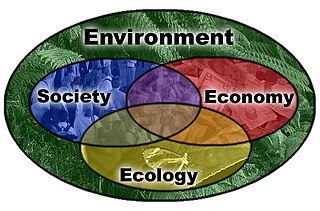Related Research Articles

An intelligent transportation system (ITS) is an advanced application which aims to provide innovative services relating to different modes of transport and traffic management and enable users to be better informed and make safer, more coordinated, and 'smarter' use of transport networks.

A system on a chip or system-on-chip is an integrated circuit that integrates most or all components of a computer or other electronic system. These components almost always include on-chip central processing unit (CPU), memory interfaces, input/output devices and interfaces, and secondary storage interfaces, often alongside other components such as radio modems and a graphics processing unit (GPU) – all on a single substrate or microchip. SoCs may contain digital and also analog, mixed-signal and often radio frequency signal processing functions.
Distributed Artificial Intelligence (DAI) also called Decentralized Artificial Intelligence is a subfield of artificial intelligence research dedicated to the development of distributed solutions for problems. DAI is closely related to and a predecessor of the field of multi-agent systems.

Distributed generation, also distributed energy, on-site generation (OSG), or district/decentralized energy, is electrical generation and storage performed by a variety of small, grid-connected or distribution system-connected devices referred to as distributed energy resources (DER).
Network congestion in data networking and queueing theory is the reduced quality of service that occurs when a network node or link is carrying more data than it can handle. Typical effects include queueing delay, packet loss or the blocking of new connections. A consequence of congestion is that an incremental increase in offered load leads either only to a small increase or even a decrease in network throughput.

A multi-agent system is a computerized system composed of multiple interacting intelligent agents. Multi-agent systems can solve problems that are difficult or impossible for an individual agent or a monolithic system to solve. Intelligence may include methodic, functional, procedural approaches, algorithmic search or reinforcement learning.
STREAMS Integrated Intelligent Transport System is an enterprise traffic management system designed to operate in the Microsoft Windows environment. Like most traffic management systems, STREAMS is an array of institutional, human, hardware, and software components designed to monitor, control, and manage traffic on streets and highways. Advanced traffic management systems come under the banner of ITS. ITS is the application of information and communications technology to transport operations in order to "reduce operating costs", "improve safety" and "maximize the capacity of existing infrastructure". STREAMS provides traffic signal management, incident management, motorway management, vehicle priority, traveler information, flood monitoring and parking guidance within a single integrated system is what the product says. STREAMS is developed by Transmax.

Active traffic management is a method of increasing peak capacity and smoothing traffic flows on busy major highways. Techniques include variable speed limits, hard-shoulder running and ramp-metering controlled by overhead variable message signs. It has been implemented in several countries, including Germany, the United Kingdom, Canada and the United States.

The smart grid is an enhancement of the 20th century electrical grid, using two-way communications and distributed so-called intelligent devices. Two-way flows of electricity and information could improve the delivery network. Research is mainly focused on three systems of a smart grid – the infrastructure system, the management system, and the protection system. Electronic power conditioning and control of the production and distribution of electricity are important aspects of the smart grid.
Traffic optimization are the methods by which time stopped in road traffic is reduced.
TransModeler is the name of a based traffic simulation platform for doing wide-area traffic planning, traffic management, and emergency evacuation studies that is developed by Caliper Corporation. It can animate the behavior of multi-modal traffic systems to show the flow of vehicles, the operation of traffic signals, and the overall performance of the transportation network.

The normal function of traffic lights requires more than sight control and coordination to ensure that traffic and pedestrians move as smoothly, and safely as possible. A variety of different control systems are used to accomplish this, ranging from simple clockwork mechanisms to sophisticated computerized control and coordination systems that self-adjust to minimize delay to people using the junction.

Computational sustainability is an emerging field that attempts to balance societal, economic, and environmental resources for the future well-being of humanity using methods from mathematics, computer science, and information science fields. Sustainability in this context refers to the world's ability to sustain biological, social, and environmental systems in the long term. Using the power of computers to process large quantities of information, decision making algorithms allocate resources based on real-time information. Applications advanced by this field are widespread across various areas. For example, artificial intelligence and machine learning techniques are created to promote long-term biodiversity conservation and species protection. Smart grids implement renewable resources and storage capabilities to control the production and expenditure of energy. Intelligent transportation system technologies can analyze road conditions and relay information to drivers so they can make smarter, more environmentally-beneficial decisions based on real-time traffic information.

Aimsun Live is a traffic forecasting solution based on simulation, developed and marketed by Aimsun.
TRANSYT-7F is a traffic simulation and signal timing optimization program. The primary application of TRANSYT-7F is signal timing design and optimization. TRANSYT-7F features genetic algorithm optimization of cycle length, phasing sequence, splits, and offsets. TRANSYT-7F combines a detailed optimization process with a detailed macroscopic simulation model.

Smart traffic lights or Intelligent traffic lights are a vehicle traffic control system that combines traditional traffic lights with an array of sensors and artificial intelligence to intelligently route vehicle and pedestrian traffic. They can form part of a bigger intelligent transport system.
Adaptive traffic control system (ATCS) is a traffic management strategy in which traffic signal timing changes, or adapts, based on actual traffic demand. This is accomplished using an adaptive traffic control system consisting of both hardware and software.
A decentralised application is an application that can operate autonomously, typically through the use of smart contracts, that run on a decentralized computing, blockchain or other distributed ledger system. Like traditional applications, DApps provide some function or utility to its users. However, unlike traditional applications, DApps operate without human intervention and are not owned by any one entity, rather DApps distribute tokens that represent ownership. These tokens are distributed according to a programmed algorithm to the users of the system, diluting ownership and control of the DApp. Without any one entity controlling the system, the application is therefore decentralised.
Carolina Osorio is a full professor in Decision Sciences at HEC Montreal. Her work is focused on operations research applied to urban transportation.

Baher Abdulhai is a Canadian civil engineer, academic, entrepreneur, and researcher. He is a Professor in the Department of Civil Engineering, Director of Intelligent Transportation Systems Centre, and Co-Director of iCity Centre for Automated and Transformative Transportation at the University of Toronto. He is also the CEO and managing director of IntelliCAN Transportation System Inc.
References
- ↑ Xiao-Feng Xie, S. Smith, G. Barlow. Smart and Scalable Urban Signal Networks: Methods and Systems for Adaptive Traffic Signal Control. U.S. Patent No. 9,159,229, 2015.
- ↑ Stephen F. Smith, Gregory J. Barlow, Xiao-Feng Xie. Smart and scalable urban signal networks: methods and systems for adaptive traffic signal control. U.S. Patent No. 9,830,813, 2017. (Continuation-in-part (CIP) to 9,159,229).
- 1 2 Xiao-Feng Xie, Stephen F. Smith, Liang Lu, Gregory J. Barlow. Schedule-driven intersection control. Transportation Research Part C: Emerging Technologies, 2012, 24: 168-189.
- 1 2 Xiao-Feng Xie, Stephen F. Smith, Gregory J. Barlow. Schedule-driven coordination for real-time traffic network control. International Conference on Automated Planning and Scheduling (ICAPS), Sao Paulo, Brazil, 2012: 323-331.
- ↑ Hu, H-C and S.F. Smith, “Softpressure: A Schedule-Driven Backpressure Algorithm for Coping with Network Congestion”, Proceedings 27thInternational Joint Conference on Artificial Intelligence, Melbourne, Australia, August 2017
- 1 2 3 Stephen F. Smith, Gregory J. Barlow, Xiao-Feng Xie, Zachary B. Rubinstein. Smart urban signal networks: Initial application of the SURTRAC adaptive traffic signal control system. International Conference on Automated Planning and Scheduling (ICAPS). Rome, Italy, 2013.
- ↑ Stephen F. Smith, Gregory Barlow, Xiao-Feng Xie, and Zack Rubinstein. SURTRAC: Scalable Urban Traffic Control. Transportation Research Board 92nd Annual Meeting Compendium of Papers, 2013.
- ↑ Walters, Ken (October 16, 2012). "Pilot Study on Traffic Lights Reduces Pollution, Traffic Clogs". CMU website. Carnegie Mellon University . Retrieved January 31, 2013.
- ↑ Barlow, G.J., S.F. Smith, X-F Xie and Z.B. Rubinstein, “Real-Time Traffic Control for Urban Environments: Expanding the Surtrac Testbed Network”, 2014 World Congress on Intelligent Transportation Systems, Detroit, MI, September 2014.
- 1 2 "Rapid Flow Technologies". www.rapidflowtech.com. Retrieved 2018-06-02.
- 1 2 Xiao-Feng Xie (2018-07-03). "Statement on the Scalable Urban Traffic Control Technology" . Retrieved 2018-07-03.
- ↑ M. Papageorgiou, C. Diakaki, V. Dinopoulou, A. Kotsialos, and Y. Wang. Review of road traffic control strategies. Proceedings of the IEEE, 2003, 91(12):2043–2067.
- ↑ Walters, Ken (2012-10-16). "Smart Signals: Pilot Study on Traffic Lights Reduces Pollution, Traffic Clogs". CMU Piper. Retrieved 2013-01-28.
- ↑ Watt, Eliza (2017-05-23). "'The right to privacy and the future of mass surveillance'". The International Journal of Human Rights. 21 (7): 773–799. doi:10.1080/13642987.2017.1298091. ISSN 1364-2987. S2CID 148928418.
- ↑ "Article: Traffic Signal Synchronization". www.imaja.com. Retrieved 2023-01-28.
- ↑ Meyer, Robinson (2012-08-16). "Sorry, Los Angeles: Synchronizing Traffic Lights May Not Reduce Emissions". Theatlantic.com. Retrieved 28 January 2013.